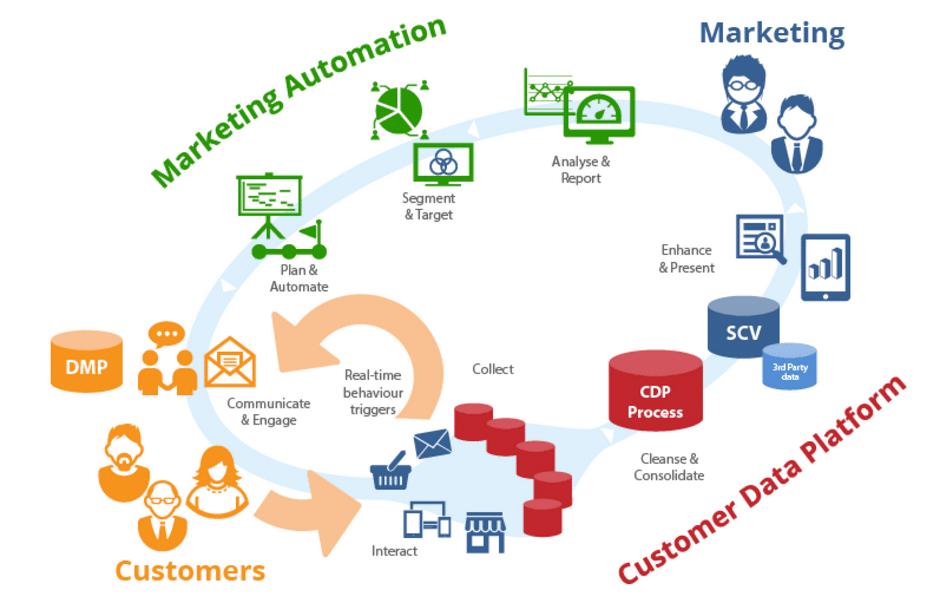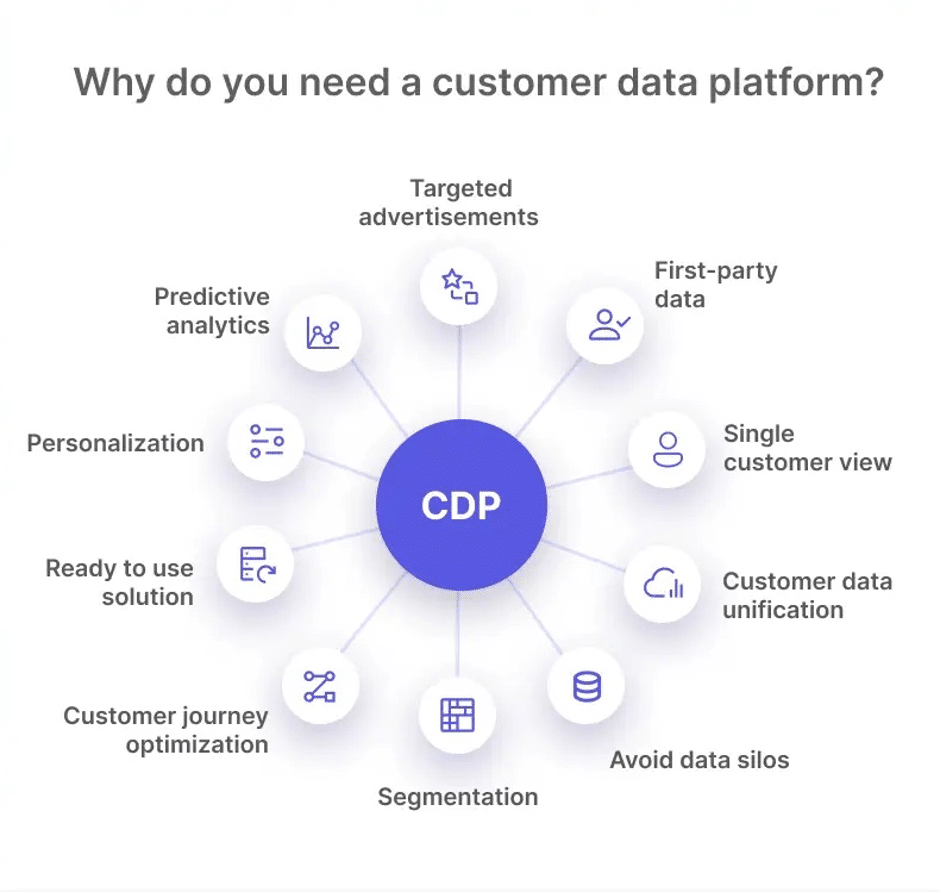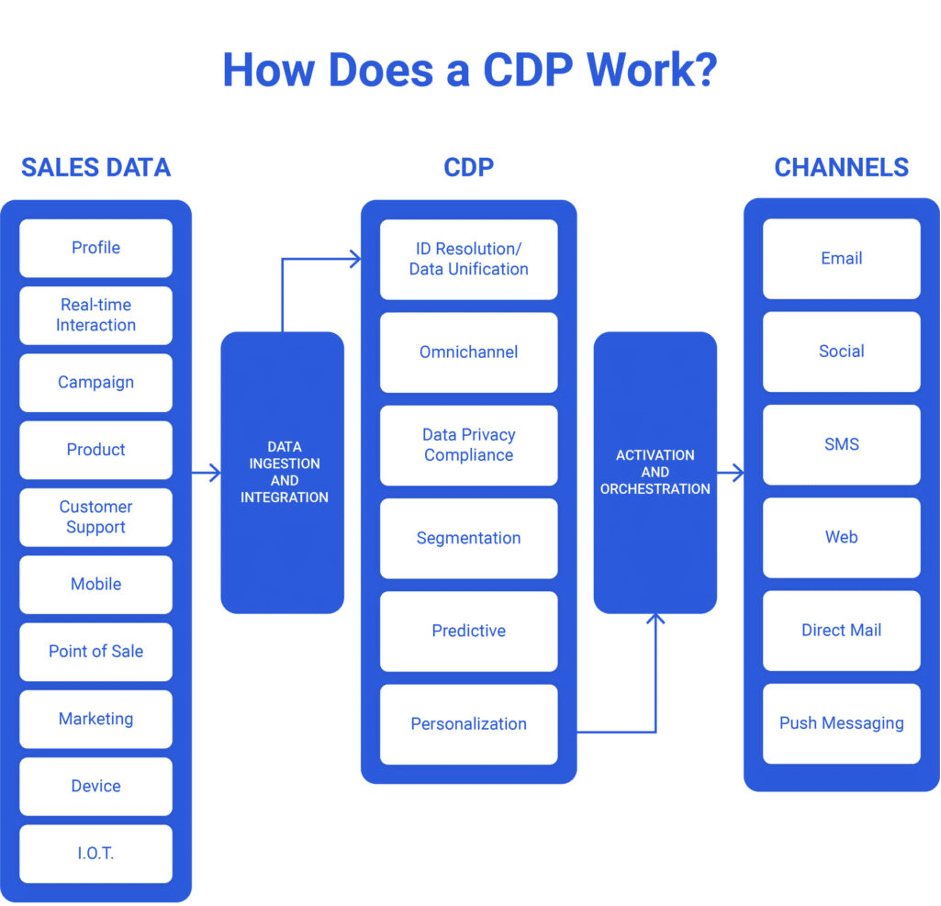Third-party cookies are on their last legs. By the second part of 2024, Google expects to have completely removed them from its browser. Both Safari and Firefox prevent tracking cookies from being used for marketing purposes. With the release of iOS 14.5, however, Apple has mandated that apps obtain user permission before using their data for tracking purposes.
Isn’t it time to switch to first- and zero-party data using corresponding marketing tools? That’s where a customer data platform (CDP) comes in handy. 68% of marketing leaders use automation platforms in their organizations, and CDP is among them. This solution allows planning for and actively encouraging your company’s continuing growth.
Customers who have their needs met are more inclined to buy again and to spread the word about your company. You need to know how and why they interact with your brand and comprehend their shifting expectations. CDPs are the foundation many organizations use to host and inquiry client information and develop profiles connected to real people.
It is time to find out how companies benefit from customer data platforms and whether you need this software.
What Is a CDP
In general, CDPs assist with improving customer experience a lot. A customer data platform is a marketing software that helps to collect disparate data on customer behavior and combine them into a single customer profile. Different systems – web and mobile, CRM, loyalty processing management software, and more – can act as data sources. This allows to form a complete client profile based on various client identifiers – email, phone numbers, cookies, loyalty program, etc.
From all gathered online and offline data, general customer profiles are made with all the data expected to further boost the client shopping experience. These profiles are utilized to come up with segmentation and analytics, send mailings and assess their performance, and carry out other marketing tasks.
Main CDP Features
To better understand the CDP meaning, one has to know how it functions. Customer data management is not the only feature of CDPs. The CDP Institute has prepared a comprehensive list of elements necessary for a client data platform.

- CDP can store all received data for as long as the user specifies.
- The platform can create unified user profiles based on all data related to the same person.
- Such platforms assist with keeping an eye on and analyzing a customer journey.
- CDP manages personal data: name, address, email address, and phone number in accordance with privacy and security rules.
- CDP can store any input data without any loss. You can physically delete input data when it is loaded into CDP, but it can be restored if needed.
- CDP technology allows other systems to access any data in customer profiles through API connections, web links, or database queries.
- A client data platform must accept data from all sources – online and offline, and formats – structured, semi-structured, and unstructured.
- The platform can select customer segments and send information with the specified data elements to other systems.
Thus, CDP accumulates information from multiple sources and combines it into a unified customer profile. Without IT intervention, CDP merges and, if necessary, eliminates duplicate consumer information.
When Is the Right Time to Implement CDP Solutions
You should first clearly understand the benefits of a customer data platform for your eCommerce or another business.
What can experts do with CDP:
- Learn everything about the preferences and interests of the target audience.
- Track the history of customer interactions with the brand and unify disparate user data.
- Anticipate customer behavior and improve interactions through accurate predictions.
- Segment the brand’s audience and prioritize communication channels with each consumer group.

When a business already knows a lot about its target audience but is having trouble processing statistics and analytics, it needs an omnichannel customer data platform. Let’s take a look at the most important requirements for putting CDP into action.
| Task to handle with CDP | How it works | Example |
| Combining online and offline customer data in the statistics database for analytics. | The CDP collects digital data and builds a complete user profile, which enables customer identification for offline purchases. | A customer adds a product to the cart but leaves the site without placing an order. After a while, an offline sale takes place, where you can identify the customer and update the data in the statistics – adjust ROI, LTV, and the contribution of channels to sales. |
| Increasing conversions by personalizing marketing and increasing customer loyalty. | The data collected is used to improve remarketing campaigns and scripts for email newsletters and many other communication channels. | The platform finely segments users and adjusts settings for precise targeting. Customers see relevant information, while businesses get a better chance of conversion. |
| Developing predictive scoring of customers. | The system processes the accumulated statistics and adjusts the scoring algorithm to build conversion forecasts for each client. | Customer profiles are enriched with scoring forecast data – the probability of opening an email newsletter or placing an order. The manager immediately understands how high the possibility of a successful transaction is. |
| Optimizing conversion and hypothesis effectiveness testing. | The platform tracks the behavioral patterns of a brand’s audience. The results of analytics are used to improve user interaction. | The collected data is used to test new hypotheses using A/B tests. Resulting insights are used for new campaigns. |
We would add the following criteria for the need to implement a CDP:
- Diverse attribute composition of customer data: user interactions, personal information, and transactions. It is not so much the number of attributes that is important, but their quality for further marketing campaigns. For example, a large number of tech characteristics of a customer’s device (operating system version, browser, screen resolution, etc.) are inferior in their usefulness for communication, even to such a characteristic as the customer’s gender.
- Multiple points of contact with the client: not only website or mobile app but also SMS, email, messengers, advertising systems, etc.
- Large customer base: CDP assists with managing large volumes of data on multiple users. For companies with a small number of customers (e.g., startups), CDP implementation may not be economically feasible, and it may be worthwhile to use a combination of web/mobile analytics and CRM systems.
- Willingness to allocate several marketers or analysts: necessary to fully utilize the platform’s capabilities.
Who Will Benefit from Using CDPs
As far as CDPs not only collect but analyze data from all possible sources, they can come up with product recommendations and suggest each client’s full picture. In particular, these specialists will benefit from using such a platform:

- Marketing team. Having access to the full client’s profile, marketing specialists can target campaigns more accurately, increasing conversions and return on investment for promotion.
- Sales team. With clients’ profiles, sales managers can use all opportunities for making a deal thanks to the information provided by a CDP (for instance, frequency of purchases, loyalty status, buying history, etc.).
- Customer service. A CDP may also be used by customer care teams to personalize the assistance they provide to each user. Data warehouse software, email software, and other data storage systems may be integrated.
It is vital to learn how to choose CDP right for your business. We are ready to share some tips:
- To pick the best CDP, you should consult with internal stakeholders.
- Define business objectives and use cases for implementing a CDP.
- Detail the technologies you wish to share with a CDP provider.
- Pick out the most important CDP tool functions.
- Find the best customer data platform provider by comparing prices and features.
Feedback might be useful as well. Do not ignore what others say about a specific marketing automation tool before deciding whether to implement it.
Final Thoughts
You need a CDP platform to correctly collect zero-party and first-party data and form a complete customer profile. Thanks to it, further work with customers will increase the effectiveness of marketing communications and improve personalized customer experience. Investing in the implementation of this software is advisable if your company needs to:
- Understand the customer journey.
- Have a single source of truth.
- Combine structured and unstructured data.
- Develop a multichannel segmentation.
- Apply advanced personalization.
Also, it is recommended if the impact of the investment is easily calculable at the scale of your business.
CDP is one of the emerging digital marketing trends your business should consider to interact better with customers.
